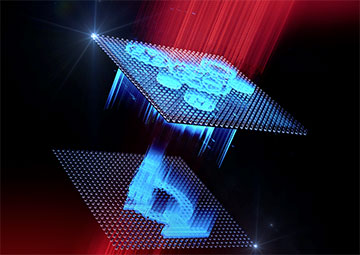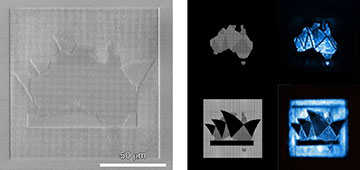
Researchers have created a nanostructured dielectric metasurface to control the transmission of light, allowing one image to be seen from the front and another from the back. [Image: Ella Maru Studio]
An international group of physicists has used a nanostructured dielectric metasurface to control the transmission of light, showing how to generate different images by illuminating the surface either from the front or the back. The researchers say that their work—which relies on the nonlinear conversion of infrared light into optical radiation—could lead to the optical equivalent of electronic diodes (Nat. Photon., doi: 10.1038/s41566-022-01018-7).
Tiny cylinders in glass
Asymmetric control of light is already exploited in areas such as telecommunications and high-power lasing, but the optical isolators used to perform the task are quite bulky and expensive. Scientists have shown how to shrink the technology by exploiting microresonators coupled to waveguides on photonic chips and have also demonstrated how a plasmonic metasurface could carry out the task. However, even this latter device relied on structures several times larger than the wavelength of incoming light—limiting its potential for creating the optical equivalent of densely integrated electronic chips.
In the latest work, Yuri Kivshar of the Australian National University in Canberra and colleagues in Australia, Germany and Singapore have shown how to achieve asymmetric control of light using planar arrays of sub-wavelength-scale dielectric cylindrical resonators embedded in glass. Each cylinder measures just a few hundred nanometers across and consists of two distinct layers—one made from amorphous silicon and the other from silicon nitride. The difference in refractive index between these two materials, as well as the size of the resonators, determine how incoming light is manipulated.
When the device is illuminated with light at the resonant wavelength, the nanocylinders’ optical response is dominated by the electric dipole and magnetic dipole (with higher-order multipoles contributing relatively little). This leads to quite a simple outcome—the magnetic dipole being enhanced and the electric dipole suppressed when illumination is from the front. The two responses reverse when light comes from behind.
Different shapes, front and back
To exploit this asymmetry for light transmission, the researchers illuminated the structure with intense laser light at infrared wavelengths and tapped the visible light produced by third-harmonic generation—a nonlinear process in which groups of three photons in the beam combine to create a single photon with three times the original frequency. Because the efficiency of this process is far higher for the magnetic dipole than it is for the electric dipole, the upshot is a brighter visible output when the infrared input is in the forward direction.
The researchers carried out their work via both simulation and experiment, in the latter case fabricating arrays using electron-beam lithography. Studying a uniform array of cylinders all just over 200 nm across and illuminated with intense light at about 1475 nm, they confirmed that the visible output was many times greater in the forward direction than it was from behind. Conversely, they showed that this contrast almost entirely disappeared both when illuminating the same material with far less intense radiation (so, failing to elicit a nonlinear response) and when exposing a uniform bilayer film to intense light (thereby lacking the unique optical response of the nanocylinders).
Researchers in Germany, Australia and Singapore used four types of distinctly shaped dielectric nanocylinders to make metasurfaces that generate different images when viewed from the forward and backward directions. Left: electron microscopy image of a metasurface layout assembled from the set of four resonators. Right: experimental design (left-hand column) and corresponding results (right-hand column). [Image: S.S. Kruk et al. “Asymmetric parametric generation of images with nonlinear dielectric metasurfaces,” Nat. Photon. (2022). doi: 10.1038/s41566-022-01018-7] [Enlarge image]
Moving to more complex structures, the researchers then designed a series of metasurfaces consisting of different arrangements of four distinctly shaped nanocylinders. Each of the four cylinder types had equally thick layers of silicon and silicon nitride to ease fabrication but had different cross-sections—three being ellipses of various sizes and the other a circle. This resulted in four distinct, complementary outputs—one transmitting visible radiation only in the forward direction, one only backward, one transmitting nearly equally in both directions and the other (with the circular cross-section) transmitting in neither.
Kivshar and colleagues used these nanocylinders to fabricate three metasurfaces that generated progressively more complex and distinct images. The first, which employed just two types of cylinder, showed a bright square in a dark circle when illuminated from the front and a dark square in a light circle when illuminated from behind. The second instead showed either light and dark stripes or a chessboard pattern, while the third revealed either a contour of Australia or a stylized version of the Sydney Opera House—again, depending on the direction of illumination.
Future directions
The researchers argue that their findings “pave the way toward novel functionalities of nanoscale optical devices beyond the limits of linear optics.” They envisage having asymmetric control over multiple electromagnetic parameters, including amplitude, phase and polarization, allowing them perhaps to generate entangled photon states asymmetrically. This, they say, may lead to nanoscale on-chip optical isolators—photonic devices similar to electronic diodes.
Before they get to that stage, however, the researchers need to overcome a number of technical hurdles. Apart from modifying the resonator design to eliminate unwanted crosstalk in images, they particularly need to improve the metasurfaces’ efficiency. Their experiments reveal that the devices transmit only around one-millionth of the input laser power—about an order of magnitude less than they calculated.
One option to try and overcome this problem involves doing away with the wavelength conversion altogether and employing what is known as nonlinear self-action. To this end, they are investigating what lead author Sergey Kruk of Paderborn University in Germany describes as “several promising materials.”

